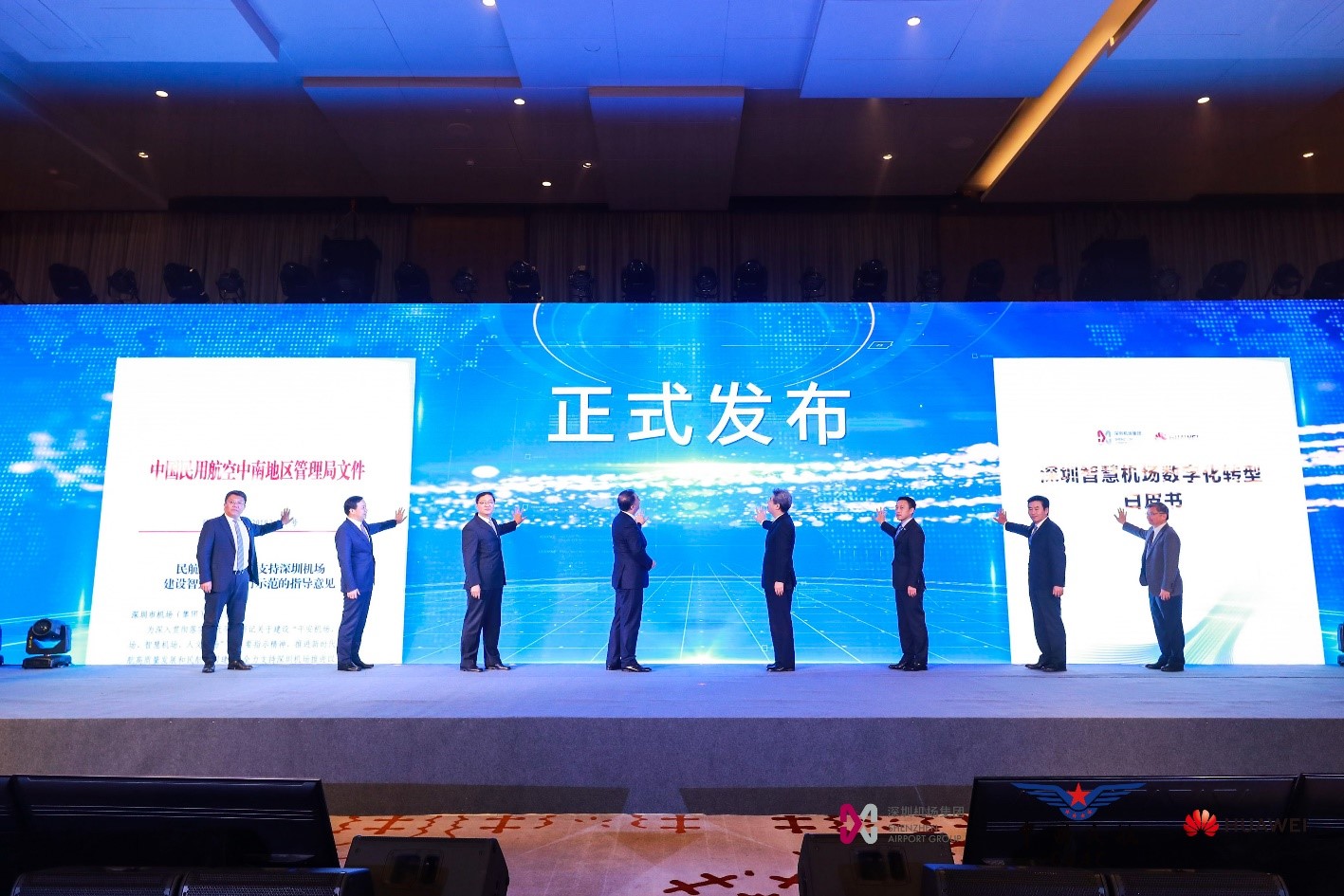このサイトはCookieを使用しています。 サイトを閲覧し続けることで、Cookieの使用に同意したものとみなされます。 プライバシーポリシーを読む>
![]()
このサイトはCookieを使用しています。 サイトを閲覧し続けることで、Cookieの使用に同意したものとみなされます。 プライバシーポリシーを読む>
![]()
企業ユーザー向け製品、ソリューション、サービス
[Shenzhen, China, December 10, 2019] The Civil Aviation Administration of China (CAAC) released guidelines to support Shenzhen Airport’s pilot in smart airport construction, at the Smart Airport Construction Meeting held in Shenzhen, China, in December 2019. Accordingly, Huawei and Shenzhen Airport published the Shenzhen Airport Digital Transformation White Paper. This introduced the airport's digital transformation and highlighted new ICT infrastructure for smart airports — ubiquitous connectivity, digital platforms, and pervasive intelligence — as a key factor in successful airport digital transformation.
Co-hosted by Huawei and Shenzhen Airport, the Smart Airport Construction Meeting was led by the CAAC Central and Southern Regional Administration. It attracted government agencies, local governments, and regional civil aviation authorities, as well as over 60 airport management companies (including 37 airports, representing tens of millions in passenger traffic), airlines, and organizations stationed in Shenzhen Airport.
Zheng Hongbo (Chairman of Shenzhen Airport), Lu Yong (Huawei's Vice-President), executives from the Shenzhen government, and directors from transportation authorities also attended.

Releasing the Guideline and White Paper
The CAAC guidelines state that the application of new technologies plays a significant role in the construction and high-quality development of safe, green, smart, and cultural airports, known as the “4-in-1 airport” strategy. Shenzhen Airport will act as the model for the new construction of smart airports and application of technologies.
In June 2017, Shenzhen Airport Group signed a digital transformation strategic agreement with Huawei, aiming to build a digital airport that provides an optimal passenger experience. To achieve this goal, the group has incorporated the principle of a smart airport as one of its development strategies. It has also established a digital management center to organize and optimize business processes, facilitating overall digital organizational transformation. The group has also built a new ICT infrastructure platform according to integrated planning, construction, and operations. In doing so, they have set up four business systems covering comprehensive operations control, security, services, and management.
In May 2019, CAAC and Huawei also signed a strategic cooperation agreement covering the top-level design and construction of intelligent aviation, the application of technological innovations and achievements, the formulation of standards, and the cultivation of talent and effective communication. Together they will make combined efforts to promote intelligent aviation construction and implement the civil aviation power strategy. The white paper release signifies substantial progress for the partnership.

Huang Yige, Vice President of Shenzhen Airport Group
"The White Paper is the outcome of current cooperation between Shenzhen Airport Group and Huawei. By releasing the White Paper, we hope to provide our peers with a reference for the construction of smart airports," said Huang Yige, Vice-President of Shenzhen Airport Group. "During smart airport construction, we look forward to enhanced cooperation and communication with our counterparts, jointly promoting the construction of 4-in-1 airports and contributing to the high-quality development of the civil aviation industry."
Mr. Huang highlighted advantage utilization, goal achievement, and technological optimization in the white paper.
Advantage utilization: A new round of industry transformation has been driven by the emerging digital economy. The construction of smart airports will drive the high-quality development of airports and improve their operational efficiency. As a result of wider industry trends, the digital transformation of airports will form a major part of wider digital transformation.
Goal achievement: Successful airport digital transformation requires a solid digital foundation, which should be built through ubiquitous connectivity, pervasive intelligence, and digital platforms equipped with various innovative ICT technologies. Airport operators should integrate technologies and services with a focus on passengers, and develop a comprehensive blueprint for smart airports featuring connectivity, platforms, and intelligence. In particular, they should focus on devices, ICT infrastructure, platforms, and applications, in order to intensify efforts to build comprehensive operations control, security, services, and management systems.
Technological optimization: Shenzhen Airport Group has made a smart airport blueprint including overall planning, solutions, enterprise architecture, and a governance system. It has constructed a new IT and data governance system through optimized top-level design, which has improved efficiency by adopting combined construction models, and ensured extremely efficient construction, using phase-by-phase implementation.
President Lu Yong said: “Huawei is committed to building a digital foundation for smart airports in the civil aviation industry. We provide Huawei Horizon Digital Platform, which integrates technologies, data, and services, to effectively support industry digital transformation. This will also help Shenzhen Airport build a business system incorporating one map for operations, one network for security, and one-stop services.
"Supported by a solid digital foundation, we will keep moving with Shenzhen Airport and our partners, to make more breakthroughs and achievements across multiple areas."

Lu Yong, Senior Vice President & President of the China Region, Huawei
Smart airports need to be constructed in a more intelligent way. Indeed, they are long-term projects requiring the full participation of industry-leading airports. Shenzhen Airport demonstrates the feasibility of smart airport construction through top-level planning, platform-based development, joint innovation, agile updates, and continuous operations. The tough challenges posed by airport digital transformation call for decisive action — Huawei firmly believes that we can only achieve success through joint efforts with our partners.